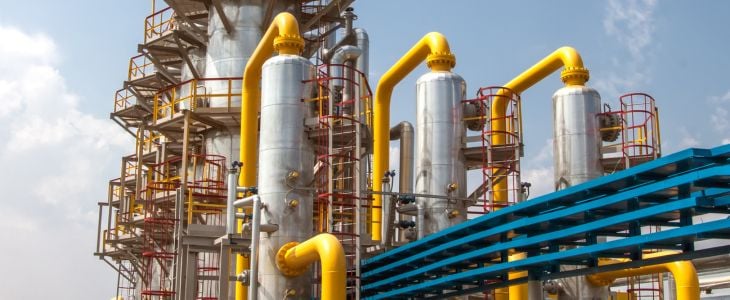From power generation to refrigeration systems, the centrifugal compressor is living a golden age as a piece of equipment. In a context in which achieving the maximum efficiency has become a much sought-after target, the centrifugal compressor has become a key component of many systems. Here’s a look at how it works and its potential advantages.
The centrifugal compressor: a definition
A centrifugal compressor is a type of dynamic compressor used to increase the pressure of a gas by converting its kinetic energy into potential energy.
Commonly used in a variety of industrial applications to compress gasses (such as air, natural gas, and refrigerants), its main role is to move gas around. It thus provides compressed air for a wide range of applications, such as pneumatic tools, or manufacturing processes, as well as being key in many high-end refrigeration applications.
It can also be referred to as an impeller compressor, a radial compressor or a turbo compressor, and it is considered as part of the other types of refrigeration compressors.
What are the parts of a centrifugal compressor
- Impeller: the rotating element of the centrifugal compressor, responsible for imparting kinetic energy to the gas and accelerating it outward towards the periphery.
- Diffuser: the high-speed gas enters the diffuser after leaving the impeller, so that it converts the high-velocity gas into high-pressure gas by reducing its velocity and increasing its pressure.
- Volute or scroll: a curved, stationary casing surrounding the impeller and diffuser, which collects the high-pressure gas from the diffuser and directs it to the compressor outlet.
- Inlet Guide Vanes (IGV) or Inlet Diffuser: an optional component, it is in charge of controlling the flow of gas entering the impeller, improving the compressor's efficiency across different operating conditions.
- Bearing and shaft: while the impeller is connected to the compressor's shaft, it transfers the rotational energy from the driver to the impeller. Bearings support the shaft and allow it to rotate smoothly.
- Seals: these are used to prevent gas leakages between the rotating and stationary components. The labyrinth seals are commonly found.
- Cooling and lubrication system: the first is crucial to maintain optimal operating temperatures, while the latter ensures that bearings and other rotating parts are properly lubricated to reduce friction and wear.
- Driver: in charge of providing the mechanical power to rotate the impeller, they can be electric motors, steam turbines, gas turbines, internal combustion engines…
- Casing: the outermost pressure containing part
- Balance drum: its role is to balance the pressure on both discharge and suction sides
- Coupling: in charge to transmit power from driver to compressor
How does a centrifugal compressor work
The centrifugal compressor displays a distinct working process from other types of compressors, such as the screw compressor. In this case, it follows the Bernoulli's principle, which states that, within the flow of an incompressible fluid (one that has negligible viscosity and follows the laws of fluid dynamics), the total energy of the fluid remains constant along a streamline, being the sum of three components: potential energy, kinetic energy, and pressure energy.
In a centrifugal compressor, the impeller blades rotate at high speeds, causing the gas to move in a circular path. This motion creates a radial acceleration, accelerating the gas towards the outer periphery of the impeller.
The impeller is in fact the heart of the centrifugal compressor. This rotating wheel with curved blades is able to draw in the gas from the center and impart kinetic energy to it.
After leaving the impeller, the high-speed gas flows into the diffuser, which then converts the kinetic energy of the gas into pressure energy by slowing it down and increasing its pressure.
Finally, the gas exits the compressor through the discharge nozzle, where it is then ready for further use or processing.

What are the advantages of a centrifugal compressor
The main advantage of centrifugal compressors is their ability to handle large volumes of gas efficiently.
This is particularly true for applications requiring medium to high flow rates and moderate compression ratios.
Additionally, compared to other alternatives, centrifugal compressors generally require less maintenance (as they have fewer moving parts) and can achieve higher flow rates.
As part of our efforts in generating increasingly efficient and sustainable district energy systems, the centrifugal compressor plays a key part in some of our developments at Araner.
For instance, centrifugal compressors can often be used in district cooling systems providing a high capacity and efficiency in sustainable and modern equipment, being able to handle large volumes of gasses efficiently.
As such, the use of centrifugal compressors in heating and cooling systems contributes to achieving the desired cooling or heating effect, maintaining temperature control, and ensuring reliable operation.
But the centrifugal compressor is also key in our turbine inlet air cooling systems. Built to boost turbine power and maximize gas turbine performance, the centrifugal compressor is a key component to ultimately cool down the intake air of the Gas Turbine (GT) and generate power output augmentation.
Get in touch with us to learn more about the use of the centrifugal compressor to boost performance in cooling energy systems.










